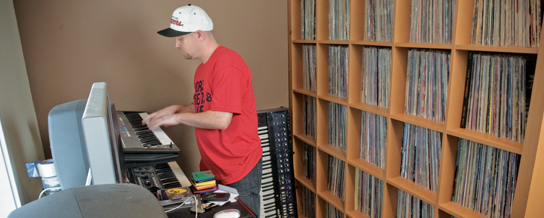In The Studio: Jake One
Seattle-based beatsmith Jake One defies classification in hip-hop. His discography this decade is as chart-topping […]

In The Studio: Jake One
Seattle-based beatsmith Jake One defies classification in hip-hop. His discography this decade is as chart-topping […]

Seattle-based beatsmith Jake One defies classification in hip-hop. His discography this decade is as chart-topping as it is depth-plumbing, including work with E-40, MF Doom, and 50 Cent. And his production process is just as unpredictable–his beats can be entirely sample-based, all live, or a hybrid of the two techniques. No matter the process, Jake aims to bring his rugged underground sound to the widest possible audience. On his debut album, White Van Music, he calls in rhymes from indie stalwarts (Blueprint, Brother Ali) and Rap City-ready acts (Young Buck, Busta Rhymes) alike. XLR8R caught up with Jake to talk about how his album came together and his irregular approach to sampling.
XLR8R: On your album, you pair MCs that normally wouldn’t work together, like Plug One and Slug, or Brother Ali and Freeway. How did those collaborations happen?
Jake One: Instead of just having different songs by different artists, I wanted to put some people together that people wouldn’t expect but that I thought would actually work. The theme of the album is just trying to make quality hip-hop and not really worrying about singles, first-week sales, and all that bullshit. It basically tries to throw all that out the window and just make songs. [With] the song “The Truth,” when Freeway did his part, I just thought [Brother] Ali would sound good on it. I wanted to put him on the record anyway, so it just came together.
I’ve read that you don’t make beats with specific MCs in mind. What inspires the whole beat-making process for you?
A lot of time it’s just listening to records and getting into the vibe. I definitely get into a style for a certain period of time; for 10 or 15 beats, I’ll do something that’s similar. But a lot of times, it’s just listening to other music. When I was doing a lot of this album, I really was listening to a lot of the stuff I grew up on, a lot of early-’90s West Coast shit like NWA, Compton’s Most Wanted. There’s definitely some songs on the album where you hear that [influence]. But I just make the beats and they fall where they fall.
Those early-’90s West Coast beats were driven by keyboard and synth stuff, which you use a lot of. Has that always been the case?
I’m not really the greatest keyboard player. I always liked a lot of that music, but I’ve always been sample-based. So for some of these records, I start ’em with a sample and then have the musicians I work with like G Koop play around with what I do and add some additional stuff to make it more interesting. When I first started making beats I was trying to be Premier. Straight up, that’s who I wanted to be. And you could hear it.
I didn’t see the MPC on your gear list on your MySpace page. Did you ever mess with that?
I have an MPC–I had a couple of ’em–I just never got the feel for it. I could fundamentally [use it], but I couldn’t necessarily have the feel that I wanted to make the beat mine. For whatever reason, the first sampler I ever had was a Roland S-10 and it was a keyboard sampler so that’s just always how I’ve worked. I had an [E-Mu] Emax after that, which is another keyboard sampler, and then I got into the [Ensoniq] EPS. Now I’m on the [Ensoniq] ASR-10, which is what I’ve been using since ’97 or something.
Given the legal issues with sampling, are you leaning more towards writing your own loops?
I’m always gonna have some sampled elements in every beat I do, whether it’s drums or a string hit or something, just ’cause that’s the texture of sound I like. I’ve actually done a lot of beats without samples. I like people to not really even know what the hell I’m doing. I don’t even want it to be known whether I’m sampling or not; it shouldn’t be obvious. When I usually do the live stuff I put a lot of work into having the process be exactly the same as when I use samples. Like that record we did in New York, “Trap Door,” with my boy G Koop; he played a different part and chopped every single note up on the ASR like how I would with a sample. It’s the same exact process. So I pretty much get the same feel when I come back with it.

